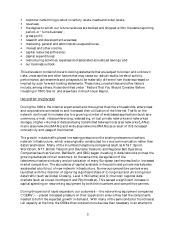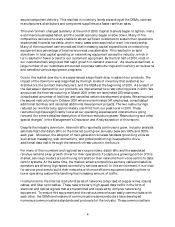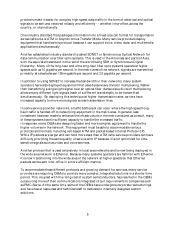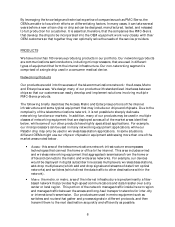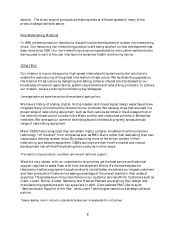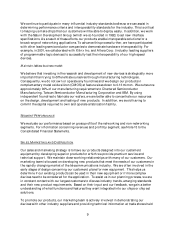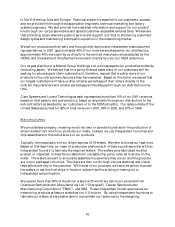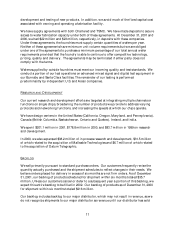Adaptec 2001 Annual Report Download - page 13
Download and view the complete annual report
Please find page 13 of the 2001 Adaptec annual report below. You can navigate through the pages in the report by either clicking on the pages listed below, or by using the keyword search tool below to find specific information within the annual report.
13
Products, Motorola, N ortel N etworks, and Texas Instruments. These companies are
concentrating an increasing amount of their substantial financial and other resources on the
markets in which we participate.
Emerging companies also provide competition in our segment of the semiconductor market.
We are aw are of venture-backed companies that focus on specific portions of our broad range
of products. These companies could introduce technologies that may make one or more of our
integrated circuits obsolete.
Over the next few years, w e expect additional competitors, some of which may also have
greater financial and other resources, to enter the market with new products.
We are also expanding into some markets, such as the wireless infrastructure and generic
microprocessor markets that have established incumbents that have substantial financial and
other resources. Some of these incumbents derive a majority of their earnings from these
markets. We expect a strong increase in competition in these markets.
LICEN SES, PA TENTS AND TRA DEMARKS
We rely in part on patents to protect our intellectual property and have been aw arded 112 U.S.
patents for circuit designs and other innovations used in the design and architecture of our
products. In addition, we have 94 patent applications pending in the U.S. Patent and
Trademark office, and 3 patent applications pending in other countries. Our patents expire
typically 20 years from the patent application date if accepted, with our existing patents
expiring between 2010 and 2020.
Our products, once designed are outlined in mask works that represent the predetermined
three-dimensional pattern of metallic, insulating, or semiconducting material present or
removed from the layers of a semiconductor chip used to produce our product. To protect our
intellectual property we rely on a combination of mask work protection under the Federal
Semiconductor Chip Protection A ct of 1984, trademarks, copyrights, trade secret laws,
employee and third-party nondisclosure agreements and licensing arrangements.
We do not consider our business to be materially dependent upon any one patent, although we
believe that a strong portfolio of patents combined with other factors such as our innovative
ability, technological expertise and the experience of our personnel are important to compete
effectively in the industry. A portfolio of patents also provides the flexibility to negotiate or
cross license intellectual property with other semiconductor companies to incorporate other
features in our products.
Our only material license is the M IPS microprocessor architecture license from MIPS
Technologies Inc., on which our microprocessor-based products are based. While the desktop
microprocessor market is dominated by the Intel Corporation’s “ x86” complex instruction set
computing, or CISC, architecture, several microprocessor architectures have emerged for other
microprocessor markets. Because of their higher performance and smaller space requirements,
most of the competing architectures, like the MIPSA architecture, are reduced instruction set
computing, or RISC architectures. The MIPS architecture is widely supported through


